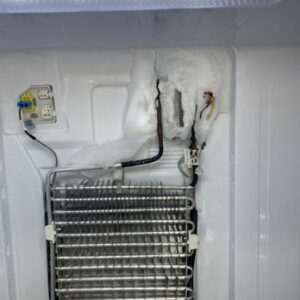Electric elements play a crucial role in various appliances, providing the necessary heat or power to make them function effectively. From stovetops and ovens to water heaters and hair dryers, electric elements are essential components that we rely on daily. Understanding the basics of electric elements, troubleshooting common problems, and maintaining them properly can help ensure their longevity and optimal performance.
Understanding the Basics of Electric Elements
Electric elements are devices that convert electrical energy into heat or power. They are typically made of conductive materials, such as metal alloys, that have high resistance to electrical current flow. When an electric current passes through the element, it encounters resistance, which generates heat. This heat is then transferred to the surrounding environment, allowing the element to perform its intended function.
There are several types of electric elements, each designed for specific applications. Some common types include heating elements, which are used in appliances like stoves and water heaters; heating coils, which are found in hair dryers and space heaters; and heating rods, which are used in industrial processes. Each type of element has its own unique design and characteristics to suit its intended purpose.
Common Problems with Electric Elements and How to Fix Them
Like any other component, electric elements can experience issues over time. Some common problems include burnt-out elements, faulty thermostats, and loose connections. Burnt-out elements occur when the element becomes damaged or worn out due to prolonged use or excessive heat. Faulty thermostats can cause the element to overheat or not reach the desired temperature. Loose connections can result in poor electrical conductivity and inefficient performance.
To troubleshoot and fix these issues, it is important to first identify the problem. If an element is burnt out, it will need to be replaced with a new one. Faulty thermostats can be repaired or replaced depending on the extent of the damage. Loose connections can be tightened or replaced if necessary. It is important to follow the manufacturer’s instructions and safety guidelines when working with electric elements.
Tips for Maintaining Your Electric Elements
Proper maintenance is essential for ensuring the longevity and optimal performance of electric elements. Regular cleaning, inspection, lubrication, and replacement of worn-out parts are key maintenance tasks that should be performed.
Regular cleaning helps remove any dirt, debris, or residue that may accumulate on the element, which can affect its performance. Inspecting the element for any signs of damage or wear is also important to catch any potential issues early on. Lubricating moving parts, such as hinges or bearings, can help reduce friction and extend the lifespan of the element. Finally, replacing worn-out parts, such as gaskets or seals, can prevent leaks or other problems from occurring.
Choosing the Right Electric Element for Your Needs
When choosing an electric element, there are several factors to consider. First, you need to determine the wattage and voltage requirements of your appliance to ensure compatibility. The wattage refers to the amount of power the element can generate, while the voltage refers to the electrical potential difference required for it to function properly.
Additionally, you should consider the size and design of the element to ensure it fits your appliance correctly. Some elements may have specific features or capabilities that make them more suitable for certain applications. It is important to consult the manufacturer’s guidelines or seek professional advice if you are unsure about which element to choose.
How to Optimize Your Electric Element’s Performance
To optimize your electric element’s performance, proper installation, correct usage, and regular maintenance are key. When installing the element, make sure it is securely connected and positioned correctly within the appliance. Follow the manufacturer’s instructions and safety guidelines to ensure a safe and effective installation.
Using the element correctly involves operating it within its specified temperature range and avoiding any misuse or abuse that could cause damage. For example, using a heating element at a higher temperature than recommended can lead to premature failure or other issues.
Regular maintenance, as mentioned earlier, includes cleaning, inspection, lubrication, and replacement of worn-out parts. By performing these tasks on a regular basis, you can help prevent problems from occurring and extend the lifespan of your electric element.
Energy-Saving Strategies for Electric Elements
Electric elements can consume a significant amount of energy, especially when used frequently or for long periods of time. Implementing energy-saving strategies can help reduce your electricity consumption and lower your utility bills.
One strategy is to use programmable thermostats, which allow you to set specific temperature levels and schedules for your appliances. This can help ensure that the element is only operating when needed and at the desired temperature.
Another strategy is to insulate your appliances to prevent heat loss. This can be done by adding insulation material around the appliance or using covers or blankets specifically designed for insulation purposes. Insulation helps retain heat within the appliance, reducing the amount of energy required to maintain the desired temperature.
Lastly, using energy-efficient elements can also help reduce energy consumption. Energy-efficient elements are designed to provide the same level of performance while using less energy compared to standard elements. Look for energy-efficient labels or certifications when purchasing new elements.
The Importance of Regular Cleaning and Inspection
Regular cleaning and inspection of electric elements are essential for several reasons. Firstly, cleaning helps remove any dirt, debris, or residue that may accumulate on the element over time. This buildup can affect the element’s performance and efficiency.
Secondly, regular inspection allows you to identify any signs of damage or wear early on. Catching these issues early can prevent further damage or potential failures from occurring. It also gives you an opportunity to address any minor problems before they become major ones.
To clean an electric element, make sure it is disconnected from the power source and cooled down. Use a soft brush or cloth to gently remove any dirt or debris. Avoid using abrasive materials or harsh chemicals that could damage the element. For inspection, visually inspect the element for any signs of damage, such as cracks, discoloration, or loose connections. If you notice any issues, consult the manufacturer’s guidelines or seek professional assistance.
Upgrading Your Electric Elements: When and Why
There may come a time when upgrading your electric elements becomes necessary. Signs that it’s time to upgrade include frequent breakdowns, decreased performance, increased energy consumption, or outdated technology. Upgrading can offer several benefits, such as improved efficiency, enhanced performance, and access to new features or capabilities.
When choosing a replacement element, consider factors such as compatibility with your appliance, wattage and voltage requirements, and any specific features or capabilities you desire. It is important to consult the manufacturer’s guidelines or seek professional advice to ensure you choose the right replacement element for your needs.
Troubleshooting Common Electric Element Issues
Common issues that can occur with electric elements include overheating, uneven heating, and no heat. Overheating can be caused by a faulty thermostat, poor ventilation, or excessive use. Uneven heating may be due to a damaged or worn-out element or improper installation. No heat can be caused by a burnt-out element, faulty wiring, or a malfunctioning thermostat.
To troubleshoot these issues, start by checking the thermostat settings and ensuring they are correct. If the thermostat is faulty, it may need to be repaired or replaced. Check for any signs of damage or wear on the element itself and replace it if necessary. Inspect the wiring connections for any loose or damaged wires and repair them as needed.
Maximizing Your Electric Element’s Lifespan
To maximize your electric element’s lifespan, proper usage, regular maintenance, and replacement of worn-out parts are crucial. Using the element within its specified temperature range and avoiding any misuse or abuse can help prevent premature failure. Following the manufacturer’s guidelines and safety instructions is important for safe and effective usage.
Regular maintenance, as mentioned earlier, includes cleaning, inspection, lubrication, and replacement of worn-out parts. By performing these tasks on a regular basis, you can help prevent problems from occurring and extend the lifespan of your electric element. Additionally, replacing any worn-out parts promptly can prevent further damage or failures from occurring.
How can I troubleshoot and optimize the electric element in my washer for maximum efficiency?
When it comes to understanding washer components functions, troubleshooting and optimizing the electric element is crucial for maximum efficiency. Start by checking for any damaged or worn out parts, and ensure proper connection and power supply. Cleaning the element regularly can also help improve its performance and efficiency.
Table of Contents
- Understanding the Basics of Electric Elements
- Common Problems with Electric Elements and How to Fix Them
- Tips for Maintaining Your Electric Elements
- Choosing the Right Electric Element for Your Needs
- How to Optimize Your Electric Element’s Performance
- Energy-Saving Strategies for Electric Elements
- The Importance of Regular Cleaning and Inspection
- Upgrading Your Electric Elements: When and Why
- Troubleshooting Common Electric Element Issues
- Maximizing Your Electric Element’s Lifespan
- How can I troubleshoot and optimize the electric element in my washer for maximum efficiency?
- Safety Precautions When Working with Electric Elements
Safety Precautions When Working with Electric Elements
Working with electric elements involves handling electricity, which can be dangerous if not done properly. It is important to prioritize safety when working with electricity to prevent accidents or injuries.
Some safety precautions to keep in mind include:
– Always disconnect the power source before working on an electric element.
– Use insulated tools and wear protective gear, such as gloves and goggles.
– Avoid working on electric elements in wet or damp conditions.
– Follow the manufacturer’s guidelines and safety instructions.
– If you are unsure about how to safely work on an electric element, seek professional assistance.
Electric elements are essential components in various appliances, providing the necessary heat or power for them to function effectively. Understanding the basics of electric elements, troubleshooting common problems, and maintaining them properly can help ensure their longevity and optimal performance. By following proper maintenance practices, choosing the right elements for your needs, and implementing energy-saving strategies, you can maximize the lifespan of your electric elements while minimizing energy consumption. Remember to prioritize safety when working with electricity and always consult the manufacturer’s guidelines or seek professional assistance when needed.



